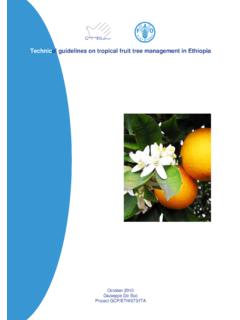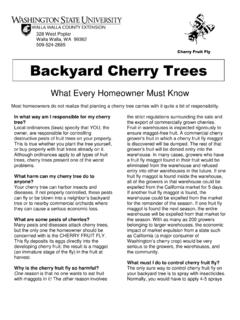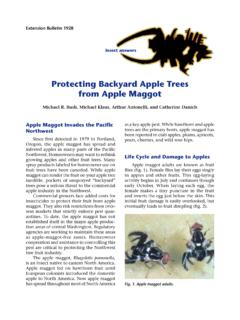Transcription of Simple Rules for Pruning Fruit Trees
1 Simple Rules for Pruning Fruit Trees Wesley R. Autio1, Winfred P. Cowgill, Jr. 2, and Jon M. Clements1 1 University of Massachusetts and 2 Rutgers University Deciduous Fruit Trees have long been a part of the home landscape. The grace of the tree and beauty of the bloom make them very attractive plants, but the taste of fresh Fruit from a well managed Fruit tree is unsurpassed. Unfortunately, however, Fruit Trees provide several horticultural challenges, a significant one being tree training. We use training rather than or in addition to Pruning to reflect the wide variety of techniques that should be used to manage both the vegetative (shoots and leaves) and the reproductive (flowers and Fruit ) growth of the tree .
2 Because of the brevity of this publication, we will concentrate on two species of tree Fruit , apples and peaches. They, generally, typify two categories: Trees which flower and Fruit largely on spurs originating on 2 year or older wood (apples, pears, plums, apricots, and cherries) and Trees which flower and Fruit on 1 year old wood (that which was produced last year) only (peaches). General Considerations Why prune and train? A desirable Fruit tree in the landscape is one which produces high quality Fruit annually, is structurally sound, and is aesthetically pleasing. Pruning and training are used to enhance light penetration into the tree canopy and as a result cause the tree to produce large and tasty Fruit throughout.
3 Pruning and training are used to increase branch strength and eliminate weak branches so that the resulting canopy is capable of carrying a Fruit crop without limb breakage. Both Pruning and training also are used to maintain the tree canopy in the available space and to make that the most visually pleasing tree possible. Be aware that there may sometimes be a conflict between optimal Fruit production and aesthetics. Tools. Pruning of Fruit Trees requires three primary tools (see Figure 1). Bypass hand pruners are a necessity. Good quality pruners, such as Felco or Pica, should cost between $35 and $60.
4 You also should have a pair of bypass loppers (24 26 ) with a nicely curved hook on the blade. Barnell, Corona, and Bahco produce loppers in this category cost between $45 and $100. The last tool is a good saw. Our favorite is a 13 curved blade Pruning saw with a Japanese style blade (Tri cut, Tiger Tooth, Turbo Cut, etc.). This is a pull saw with a very sharp blade and costs between $20 and $30. It is best also to purchase a sheath or scabbard for the saw to both protect the blade and you from the blade ($20 to $30). Season of Pruning . Pruning is best done on dry days in the late winter or early spring.
5 Apples, Figure 1. Basic tree Fruit Pruning , can be pruned as late as early June with no ill effects. Water sprouts can be removed in mid summer. Removal of larger branches in the summer, fall, or early winter greatly enhance the odds of winter damage, since Pruning is physiologically stimulating to the tree and reduces hardening. Peaches are very sensitive to trunk diseases, so Pruning is best timed to occur in the early spring, near bloom. At this time of year, the tree s metabolism is active and Trees are able to heal the damage quickly. Pruning and Training Apple Trees As noted above, apple Trees flower and Fruit on spurs borne on 2 year old and older wood.
6 The greatest number and highest quality Fruit are produced on wood that is between 3 and 4 years old. Pruning and training efforts are focused on maximizing the amount of fruitful wood in a tree and providing the conditions where this wood can produce Fruit of high eating quality. Much research and experience has shown that the easiest tree form with which to attain these goals is a central leader, a tree with a single trunk and generally a conical shape (see Figure 2). We will detail a few of the approaches necessary to obtain and maintain the ideal tree . To prune or not to prune! With a young, newly planted tree , it is important to avoid Pruning as much as possible.
7 Pruning will delay the onset of flowering and fruiting, and it will reduce the amount of Fruit obtained early in the life of the tree . This is not to say that you should avoid working with your newly planted tree . This is the time, instead, when you will rely on other techniques to manage the growth of the tree . Limb bending. It is amazing how much the limb angle from the trunk can affect the growth and fruiting of that limb. It starts when the limb is very small. Moving the young limb so that it has about a 90o angle from the trunk will ensure that it will have a strong connection to that trunk, one that will not break under several pounds of Fruit .
8 The best time to establish this angle is when the shoot is about 6 inches long, may be some time in late May or early June. This angle is easily set with a clothespin clamped onto the trunk above the shoot (see Figure 3). After a strong crotch angle is established, limb bending is used to alter vegetative growth and flowering/fruiting. More specifically, a limb growing vertically will produce a very strong growth, mostly from the tip buds, and very little Fruit . One growing horizontally, on the other hand, will produce only a small amount of growth distributed throughout the branch and will produce many more Fruit .
9 Adjusting the angle between vertical and horizontal (or even below horizontal) allow you to manipulate growth and fruiting (see Figure 3. Wooden clothespin used to maintain a wide angle between the branch and the trunk (at the end of the season). Figure 4. Limb angle can affect both shoot growth and fruiting. Figure 2. Conical shape of a central leader apple tree . Figure 4). In general, a conically shaped tree can be obtained by maintaining lower branches inclined at about 45o and upper branches horizontal or declined by 10 20 o. This approach can result in the development of a conical shape without Pruning .
10 It is important to realize that the vigor of a tree is naturally greater at the top than the bottom, so if you set the angles throughout the tree to the same angle, the strongest branches will be at the top and the weakest at the bottom (see Figure 5). Limb bending can be performed with any approach which gives the desired results. Popular approaches include tying with string or rubber bands, weights, spacing with sticks or wires. Pruning . When a tree begins to mature, Pruning becomes a more important part of the training process. It is difficult to give a full description of the art and science of Pruning .






